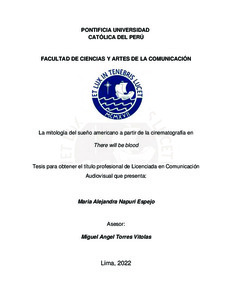| dc.contributor.advisor | Torres Vitolas, Miguel Angel | |
| dc.contributor.author | Napuri Espejo, Maria Alejandra | |
| dc.date.accessioned | 2022-12-05T19:14:47Z | |
| dc.date.available | 2022-12-05T19:14:47Z | |
| dc.date.created | 2022 | |
| dc.date.issued | 2022-12-05 | |
| dc.identifier.uri | http://hdl.handle.net/20.500.12404/23884 | |
| dc.description.abstract | En este trabajo de investigación de carácter explicativo se busca analizar cómo la
cinematografía expresa el concepto de sueño americano en la película There will be blood,
dirigida por Paul Thomas Anderson y fotografiada por Robert Elswit en el año 2007 con la
productora Paramount Vantage. Combinando un análisis visual con uno social, este trabajo
reflexiona sobre la producción de contenido a nivel narrativo en un producto audiovisual de
ficción de largometraje. La principal motivación para este trabajo es la curiosidad personal
por ver cómo se relaciona lo social dentro de lo narrativo en un producto audiovisual de
ficción de largometraje. Para conseguirlo, he elegido siete secuencias relevantes de los cuales
hay tablas de análisis de contenido donde voy a utilizar conceptos teóricos de carácter socio
semiótico, tales como el drama social, fachada social, el rol e interacciones en sociedad. De
esta manera podré entender el trasfondo del filme para poder analizar el subtexto expresado
en la imagen. Del mismo modo, utilizaré conceptos de carácter narrativo y visual para
reforzar este análisis de manera aún más profunda, tales como la lucha por el deseo, la
relación protagonista y antagonista, el subtexto, la iluminación y el encuadre. El trabajo
concluye que en la película el sueño americano deviene en pesadilla en el momento en que
el personaje principal, Daniel Plainview, logra su acción dramática. A nivel visual, esto es
representado sobre todo en el uso de luz y sombras, el ángulo y los movimientos de la cámara,
y la composición de los encuadres. | es_ES |
| dc.description.abstract | This research seeks to demonstrate the way in which cinematography visually expresses how
the concept of the American dream becomes a nightmare once it is obtained by Daniel
Plainview, the main character of There Will Be Blood, a film directed by Paul Thomas
Anderson and photographed by Robert Elswit. The main motivation for this work is the
academic interest to see how the social aspects of the film relates within the narrative in a
feature-length fiction audiovisual product. To achieve this, I’ve chosen seven relevant
sequences to analyze throught this research. I will support this analysis with content analysis
tables where I will use theoretical concepts of a socio-semiotic nature, concepts such as social
drama, social façade, the role in a community, and interactions in society. Also, I will be able
to understand the background of the film in order to analyze the subtext driven by the image.
Therefore, I will use narrative and visual concepts to reinforce this analysis in a deeper way,
such as the fight for desire, the protagonist and antagonist relationship, subtext, lighting and
framing. This way I would be able to confirm at the end of this research that the American
dream becomes a nightmare once the character has lost his social façade and is completely
isolated from the society in which he finds himself. On a visual level, this is represented
above all by the use of shadows, the composition of the frame, the angle, and camera
movements in There Will Be Blood. | es_ES |
| dc.language.iso | spa | es_ES |
| dc.publisher | Pontificia Universidad Católica del Perú | es_ES |
| dc.rights | info:eu-repo/semantics/openAccess | es_ES |
| dc.rights.uri | http://creativecommons.org/licenses/by-sa/2.5/pe/ | * |
| dc.subject | Cine--Aspectos sociales | es_ES |
| dc.subject | Teatro y sociedad | es_ES |
| dc.subject | Drama--Aspectos sociales | es_ES |
| dc.subject | Sueño americano | es_ES |
| dc.subject | Representación fílmica | es_ES |
| dc.title | La mitología del sueño americano a partir de la cinematografía en There will be blood | es_ES |
| dc.type | info:eu-repo/semantics/bachelorThesis | es_ES |
| thesis.degree.name | Licenciado en Comunicación Audiovisual | es_ES |
| thesis.degree.level | Título Profesional | es_ES |
| thesis.degree.grantor | Pontificia Universidad Católica del Perú. Facultad de Ciencias y Artes de la Comunicación. | es_ES |
| thesis.degree.discipline | Comunicación Audiovisual | es_ES |
| renati.advisor.dni | 10684078 | |
| renati.advisor.orcid | https://orcid.org/0000-0001-5817-9013 | es_ES |
| renati.author.dni | 47911561 | |
| renati.discipline | 211086 | es_ES |
| renati.juror | Oliart Velarde, Rosa Maria | es_ES |
| renati.juror | Torres Vitolas, Miguel Angel | es_ES |
| renati.juror | Bustamante Quiroz, Emilio Alberto | es_ES |
| renati.level | https://purl.org/pe-repo/renati/level#tituloProfesional | es_ES |
| renati.type | https://purl.org/pe-repo/renati/type#tesis | es_ES |
| dc.publisher.country | PE | es_ES |
| dc.subject.ocde | https://purl.org/pe-repo/ocde/ford#5.08.00 | es_ES |







